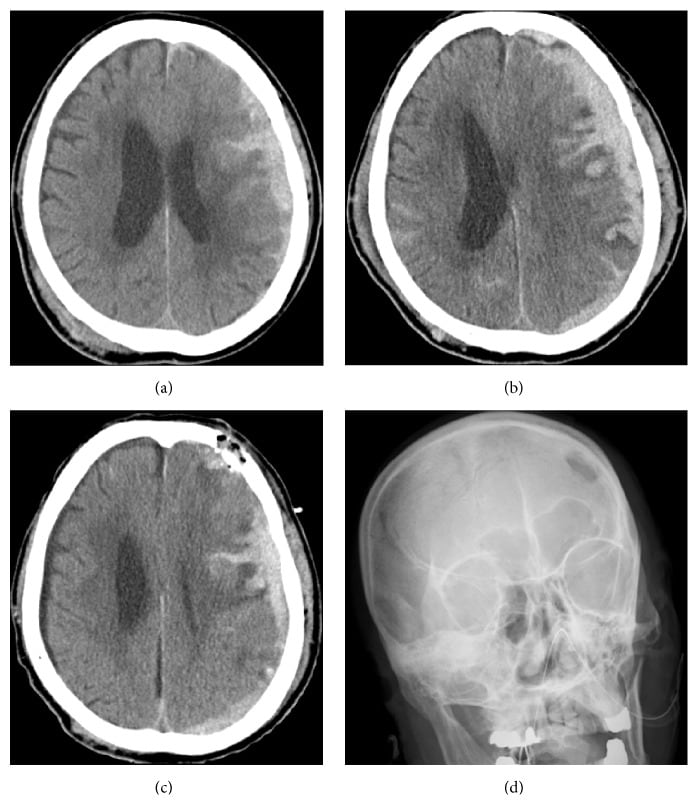The brain is prone to trauma due to hard skull surrounding the soft brain tissue in a relatively tight space. CNS trauma can be seen in motor vehicle accidents, sports injuries, falls and acts of violence. Following types are seen:
(I) Parenchymal brain damage: Trauma to the brain can cause concussion which is characterized by transient neurological dysfunction and loss of consciousness without any morphologic changes. Diffuse axonal injury may be seen. Repeated concussions, like in sports, can result in dementia, irritability, insomnia and emotional disturbances called the “post-concussion syndrome”. Dementia Pugilistica or chronic traumatic encephalopathy, also called “punch-drunk syndrome” or “boxer’s dementia”, is a form of dementia that poses a serious long-term threat to individuals involved in contact-heavy sports like boxing, or who have sustained multiple concussions throughout their lives. It typically takes about 10-15 years for symptoms to appear. Clinical features mimic Alzheimer’s syndrome. Amyloid plaques are seen on histopathology. The brain shows atrophy, dilatation of the lateral and third ventricles, and thinning of the corpus callosum. Microscopic examination reveals hyperphosphorylated tau deposition, amyloid plaques and TDP-43 inclusions.
Blunt brain trauma can cause contusions, which shows damage to small blood vessels. Coup injuries are seen at the site of impact while contrecoup injuries are seen opposite to the site of impact. Both diffuse axonal injury and contusion are seen following sudden acceleration-deceleration injuries. Diffuse axonal injury is seen in sudden angular acceleration or deceleration causing axonal shearing as the cerebrum moves back and forth over a relatively fixed brainstem. It presents as loss of consciousness, coma and persistent vegetative state. Imaging shows multiple, small hemorrhagic or non-hemorrhagic lesions at the grey-white matter interface, corpus callosum and brainstem. EM shows axonal swellings at the nodes of Ranvier called spheroids.
(II) Epidural haematoma: Blood collects between the dura and the skull. It follows fractures of the temporal or parietal bones causing rupture of the middle meningeal artery. The haematoma does not typically cross the suture lines. An asymptomatic or lucid interval may be seen after trauma followed later by neurological deterioration. Imaging shows a hyperdense, biconvex or lentiform mass. More translucent areas may be seen in the presence of active bleeding or older hematomas.
(III) Subdural haematoma: Blood collects under the dura mater, between the dura and arachnoid mater. It results from rupture of bridging veins between the dural venous sinuses and brain. It can be acute or chronic. Most common cause is blunt trauma. The hematoma may not present with any symptoms and may be missed. It is also seen as an adverse effect of anticoagulant therapy and in child abuse. Chronic subdural hematoma is associated with atrophy of the brain, which predisposes the veins to rupture. It may cause dementia. On noncontrast CT scan, an acute subdural hematoma appears as a hyperdense (white), crescent-shaped mass under the skull, not limited by suture lines. Moderate or large subdural hematomas are associated with midline shifts. In the second and third weeks, subdural hematomas become less dense and appear isodense or hypodense to the skull. Chronic subdural hematomas appear hypodense.

a) Axial plain CT scan at the time of admission shows left acute subdural hematoma and bilateral frontal contusion with thickness of 14 mm and midline shift of 8 mm. There is a bruised area in the right parietal region without bone fracture. (b) Axial plain CT scan 72 hours after admission shows worsened acute subdural hematoma with thickness of 16 mm and midline shift of 9 mm. Massive contusion of the left frontal lobe has occurred. © Radiographic frontal view shows the location of the burr hole 4 cm above the left eyebrow. (d) Axial plain CT scan after surgery shows reduced hematoma. Midline shift had improved to 4 mm. There is a small amount of air in the subdural space. Burr hole is covered by bone powders.
(IV) Shaken baby syndrome: It occurs due to child abuse involving shaking an infant vigorously. It causes traumatic brain and sometimes,cervical spine injury which may be associated with HIE. Infants present with coma, hypotonia, apnea, lethargy, vomiting etc. Characteristically, subdural hematoma and retinal hemorrhages are seen.
Sign up for free to take 6 quiz questions on this topic